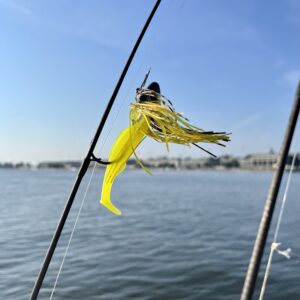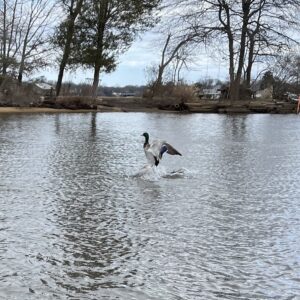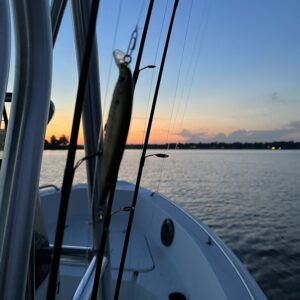Welcome to the Weekly Creel, a compilation of regional angling & conservation news headlines and announcements for anglers and outdoor enthusiasts of the Chesapeake Bay region. Please email us at editor@reelchesapeake.com to have your news or event listing considered for next week’s column. Here are direct links to the lastest, local fishing reports from Reel Chesapeake, On The Water, Maryland Department of Natural Resources, Anglers Sports Center, Fish in OC, and FishTalk Magazine. The leading photograph (above): In the proposed Southern MD Woodlands National Wildlife Refuge, the entire Patuxent watershed from St. Mary’s County through Anne Arundel would be included. Pictured is the Pax at Governor Bridge, taken a couple weeks ago.
New National Wildlife Refuge in Southern Maryland
The U.S. Fish and Wildlife Service is seeking public review and comment on a draft proposal and environmental assessment establishing the Southern Maryland Woodlands National Wildlife Refuge in Anne Arundel, Calvert, Charles, Prince George’s and St. Mary’s counties. The proposal would conserve up to 40,000 acres in fee-title acquisitions or easements from willing sellers across four watersheds, helping to conserve habitats that support threatened and endangered species, waterfowl and migratory birds of conservation concern.
As proposed, the new refuge would consist of four watershed-based units: the Lower Patuxent-Calvert Unit, Nanjemoy-Mattawoman Unit, Zekiah–Wicomico Unit, and McIntosh Run-St. Mary’s Unit. The total area of the proposed refuge acquisition boundary is about 577,420 acres. Within this geography, the Service proposes to acquire up to 40,000 acres through a combination of fee-simple and conservation easement purchases from willing sellers, to be managed as part of the National Wildlife Refuge System. The Service would continue to facilitate partner-led efforts to conserve important habitats across the remaining conservation area.
“The forests and wetlands of Southern Maryland provide special places for people and for wildlife. As these habitats come under pressure from climate change and other threats, this proposal would help conserve these areas for future generations,” said Scott Kahan, chief of the National Wildlife Refuge System for the Service’s northeast region. “We look forward to working with local communities and partners and receiving their feedback.”
The public may now review possible impacts and alternatives online at: https://www.fws.gov/project/evaluating-new-refuge-lands-southern-maryland, including the proposal, draft Land Protection Plan and Environmental Assessment (page 19 has the map).
All interested parties have the opportunity to participate and provide comments during the open 45-day public comment period. Please submit comments to: FW5southernmarylandplan@fws.gov. All comments must be received by April 22, 2024.
Six Billion Oysters Planted in Bay
Following a banner year for Chesapeake Bay oyster restoration and aquaculture, the Chesapeake Oyster Alliance (COA) announced it has recorded a new total of six billion oysters directly added to the Bay since 2017; more than halfway to the group’s goal to promote adding 10 billion new oysters to the Bay by 2025. The majority of contributions toward the 10 billion oyster goal come from major restoration initiatives in Maryland and Virginia targeted toward 11 Bay tributaries, which are on track to be completed by 2025.
“We’re seeing an exciting oyster renaissance on the Bay, from massive tributary scale-efforts down to widespread citizen involvement and public awareness,” said Tanner Council, COA Senior Manager for the Chesapeake Bay Foundation. “At least six billion oysters have been added to the Chesapeake in recent years thanks to heroic work by Maryland and Virginia, federal partners, and COA aquaculture and restoration partners.”
The 2023 oyster count in Maryland was elevated by a record year for oyster restoration thanks to large-scale restoration work by the Maryland Department of Natural Resources (DNR), National Oceanic and Atmospheric Administration, U.S. Army Corps of Engineers, and Oyster Recovery Partnership.
In Virginia, an outstanding year for oyster aquaculture saw a total of about 119 million oysters recorded in the Commonwealth in 2023. Virginia aquaculture numbers in recent years range from a low of 86 million in 2020 to a high of 129 million in 2022. Oyster aquaculture operations raise these oysters to sell to restaurants and consumers, supporting local economies while filtering water and creating habitat.
A significant number of oysters were also added through small-scale restoration work and the efforts of individuals and small businesses through programs like oyster gardening. These efforts are a great example of how the people and partners throughout the region have embraced the many benefits of oyster restoration and aquaculture.
The Chesapeake Bay Foundation (CBF) founded the Chesapeake Oyster Alliance in 2018 to spark momentum and innovation to bring back oysters from historically low levels. COA has grown to include more than 110 nonprofits, academic institutions, businesses, and aquaculture operations. Together, these partners advocate for accelerating oyster restoration, science-based fisheries management and expanding the oyster aquaculture industry throughout the Bay.
SAV Restoration in South, West, and Rhode Rivers
In 2024, Arundel Rivers Federation (Arundel Rivers) will propel the restoration of underwater grasses across Maryland’s Western Shore by constructing and managing a submerged aquatic vegetation (SAV) turbulator—a machine that separates seeds from underwater grasses to support restoration efforts. The project will be made possible through funding by the Chesapeake Bay Trust and through a collaboration between Arundel Rivers, Maryland’s Department of Natural Resources (DNR), Anne Arundel Community College’s (AACC) Environmental Center, and Anne Arundel County’s Department of Recreation and Parks. The funding will enable Arundel Rivers and its partners to restore grass beds across the South, West, and Rhode Rivers of Anne Arundel County, engage volunteers in that restoration effort, increase awareness of the benefits of these grass beds to water quality and habitat, and potentially provide precious grass seeds for other restoration projects across the state.
“This is a really exciting new project for Arundel Rivers,” said Elle Bassett, the South, West, and Rhode Riverkeeper at Arundel Rivers. “SAV is critical to the health of our waterways and I’m looking forward to getting my hands dirty with volunteers and project partners to restore native grass beds right here in Anne Arundel County.”
The Bay Program also set a more targeted goal of restoring over 800 acres of SAV in the South, West, and Rhode Rivers. Unfortunately, SAV restoration continues to lag far behind with minimal SAV found in these local waterways over the past few years. Learn more about the project at Arundel Rivers’ website.
Lake Marion Restoration Begins
This spring, Lake Marion in Severn, Maryland will undergo large-scale restoration to enhance the lake’s habitat and restore its capacity to store and treat stormwater. After years of planning by nearby residents, partners from the Provinces Civic Association, Arundel Rivers Federation (Arundel Rivers), and Severn River Association (SRA) will soon break ground on the $3.8M lake restoration project.
Lake Marion is at the very beginning, or headwaters, of the Severn River and was originally a natural stream that was converted into a stormwater management feature in the 1970s designed to collect potentially harmful stormwater runoff from surrounding communities. After filtering stormwater for more than half a century, the lake has filled with sediment and debris, causing it to overflow sending polluted stormwater into a headwater tributary of the Severn River and eventually into the Chesapeake Bay.
“Severn River Association is incredibly excited about this project to breathe fresh life into Lake Marion.” Said Ben Fertig, Restoration Manager at Severn River Association. “This is a fabulous opportunity to improve water quality, reduce sediment and nutrient pollution, and to deliver cooler, cleaner water to the Severn Run Natural Area.” Learn more at the project’s website here.
Seventh Maryland Master Angler Awarded

Zeljko “Zee” Koretic of Middle River, Baltimore County, has earned a Master Angler Milestone Award under the Maryland Department of Natural Resources’ FishMaryland program. The award recognizes recreational anglers who catch ten different species of fish in Maryland at trophy-size length. Koretic is the seventh Master Angler since the program began in 2019.
Koretic’s qualifying catches were:
- Red drum, 43 inches
- Northern snakehead, 34.5 inches
- Striped bass, 49 inches
- Cobia, 48 inches
- Channel catfish, 30.5 inches
- Summer flounder, 24 inches
- Largemouth bass, 21.5 inches
- Yellow perch, 14.25 inches
- Blue catfish. 41.5 inches
- Black crappie, 15.5 inches
Congratuations Zee!
Fed Funding to Boost Maryland’s Blue Catfish Seafood Industry
Last week, U.S. Senators Chris Van Hollen and Ben Cardin visited Tilghman Island Seafood in Talbot County—the only USDA-certified blue catfish processing facility on Maryland’s Eastern Shore–to highlight federal resources that they fought to pass in the recently enacted fiscal year 2024 agriculture appropriations bill to support catfish processing and protect other species in the Bay. The Senators were joined by Maryland Secretary of Natural Resources Joshua Kurtz, Maryland Agriculture Secretary Kevin Atticks, and local officials.
“Blue catfish pose a growing environmental and economic threat to our treasured Chesapeake Bay as they grow in number and prey on our iconic blue crabs and rockfish,” Senator Van Hollen said. “Fortunately, blue catfish are also delicious, meaning this is a problem we can literally eat our way out of. In order to facilitate getting more blue catfish on the menu, Senator Cardin and Congressman Harris and I have secured resources to boost catfish processing and spur market demand, as we continue to explore additional ways to control their population growth.”
Measures in the FY24 ag appropriations bill to address blue catfish include:
- $3 million for the USDA Rural Development Meat and Poultry Processing Expansion Program (MPPEP) and includes report language encouraging the U.S. Department of Agriculture (USDA) to prioritize proposals that support the processing of invasive wild-caught catfish.
- Up to $1 million available for the USDA Food Safety and Inspection Service (FSIS): The USDA inspection process has proven more burdensome when compared to the FDA, as FSIS inspection personnel must be present at least once per shift at catfish processors. This poses challenges since unlike meat processing—which can be done at set times—catfish processing can vary based on timing of the catch. To help address this issue, the lawmakers secured $1 million in funding to offset the costs of inspectors’ overtime pay when inspections are required outside of traditional daytime working hours.
- Including wild-caught catfish under USDA’s Agricultural Marketing Service, Section 32: Section 32 allows the USDA Agricultural Marketing Service (AMS) to make commodity purchases and other disaster assistance, which are diverted to the National School Lunch Program and other domestic food assistance programs. Including wild-caught catfish under Section 32 is intended to help remove surplus from the market and spur more demand.
- $500,000 for Invasive Catfish Control through USDA’s Animal and Plant Health Inspection Service (APHIS): Equips the Maryland Department of Natural Resources to improve our understanding of blue catfish. Funding could be used to monitor and understand where catfish are in the Bay, their seasonal movement, and where they spawn; further study their diet patterns; develop early warning systems to facilitate early removal from new tributaries; and test removal methods.
Mr. Trash Wheel, Zeke’s Coffee Collab for Cleaner Water
Mr. Trash Wheel, the beloved trash interceptor in Baltimore’s Inner Harbor, and Zeke’s Coffee, a beloved local coffee roastery, have come together in celebration of Mr. Trash Wheel’s 10th Anniversary to release a new coffee blend. The collaboration introduces the Mr. Trash Wheel Coffee Blend, a unique combination of dark roasted Mexican beans and lightly roasted Ugandan beans, resulting in a full-bodied cup with notes of almond, cocoa, nutmeg, and a pleasant sweetness.
“As our loyal fans know, we are quite proud of our city. We have been operating in Northeast Baltimore for 19 years, and the connections we’ve made far surpass the difficulties of running a business,” said Brett Rhodes, manager of Zeke’s Coffee. “We are happy to be collaborating with the Waterfront Partnership of Baltimore to beautify and improve the quality of our waterways, such a great cause that will benefit all of us. We look forward to making sure Mr. Trash Wheel is fueled by Zeke’s for years to come.”
The official release of the Mr. Trash Wheel Blend coincides with Mr. Trash Wheel’s 10th Anniversary event on Saturday, April 20th, with the coffee available for purchase both at the event and online thereafter. Attendees of Mr. Trash Wheel’s 10th Anniversary will be among the first to enjoy a taste as they receive a sample of the blend along with a Mr. Trash Wheel “Wheely Wired” coffee mug. Purchase tickets and for Mr. Trash Wheel’s 10th Anniversary, here. A portion of every sale of the Mr. Trash Wheel Blend will directly contribute to the Healthy Harbor initiative, supporting its mission for cleaner waterways.
End of the Line…
Some odds and ends, event announcements, etc.
On Tuesday, March 26th, the Boatyard Bar & Grill will host Anglers Night with Coastal Conservation Association Maryland presenting its annual Pickerel Championship Awards, plus a panel discussion on pickerel, panfish, perch, and all-things Chesapeake with special guests Capt. Jonathan Bland, Shawn Kimbro, and Capt. Tom Weaver. Click here for details.
We received word from Scott Steers, founder of nonprofit Lucky & Blessed Fishing, about a special Autisim Awareness/Fishing event he’s organizing. The 2024 Lucky and Blessed Fishing Autism Awareness/Fishing Event with Boundless Edventures (www.boundlessedventures.org), taking place April 6th (9 a.m. to noon) at Sandy Point State Park in Annapolis. “We have been building community with B.E. over that last two years through many unique local fishing adventures and we now have put together an awesome team of five fishing boats that will be taking us all out to fish the Bay,” Steers says. “We already have some amazing partners providing food (Ashling Kitchen & Bar) and fishing gear (1st Wash. Mortgage) and recently secured a t-shirt sponsor (www.hawgfin.com).” Learn more about Lucky & Blessed, as well as event details here.
Hops on the River in Salisbury is on! The April 13th event runs from 2–5 p.m. in the area between Unity Square and Riverwalk Games Park, with VIP attendees able to enter early at 1 p.m. All ticketed attendees will receive a tasting glass sponsored by The Brick Room. The event will also feature live music by Bravenoise, games, and food and craft vendors. Evolution Craft Brewing Co., RAR Brewing, Burnish Beer Co., Sinepuxent Brewing Company and Big Truck Farm Brewery all plan to have brewery representatives pouring and sharing information on-site, with more breweries to be confirmed. To learn more or buy tickets, visit https://downtownsby.com/hops-on-the-river/.
And that’s a wrap for this edition of The Weekly Creel. If you have news to share, please send an email to editor@reelchesapeake.com.











